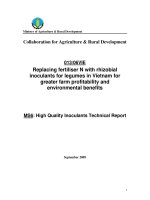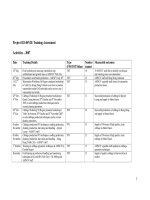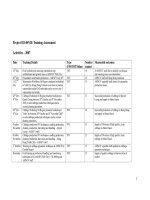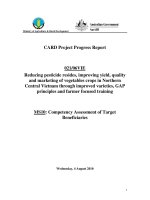Báo cáo khoa học nông nghiệp " Reducing pesticide residues, improving yield, quality and marketing of vegetables crops in Northern Central Vietnam through improved varieties, GAP principles and farmer focused training " docx
Bạn đang xem bản rút gọn của tài liệu. Xem và tải ngay bản đầy đủ của tài liệu tại đây (227.46 KB, 13 trang )
Report of household farmer survey
In the Nghe province, Viet Nam (2010)
Mr. Pham Hung Cuong
CARD PROJECT ID: 021/06VIE
2
Attachment A. 021VIE/06 REPORT FACT SHEET
Title of report Report of baseline survey, 2010
Date report submitted March. 29
th
2010
Type of report - progress/final Final survey report
Project name:
Reducing pesticide residues, improving yield, quality and
marketing of vegetables crops in Northern Central
Vietnam through improved varieties, GAP principles and
farmer focused training (021/06VIE)
Name/ Address of
collaborating person
Pham Hung Cuong
Agricultural Science Institute of Northern Central Vietnam
Vinh city, Nghe An province, Vietnam.
Email:
Tel: +84.904383088
Author report Pham Hung Cuong
Name & Function of Project
staff
Site Coordinator
AHR Contact Dr. Gordon Rogers, Applied Horticultural Research
Faculty of Agriculture Food and Natural Resources
Biomedical Building (ATP)
University of Sydney NSW, 2006, Australia
Phone 02 8627 1010 (Int: +61 2 8627 1040)
Fax 02 9544 3782 (Int: +61 2 9544 3782)
Email:
Website: www.ahr.com.au
KEYWORDS Country/ Region: Nghe An, Vietnam
Crops: Vegetables: Brassica, cucurbits
Subject: Baseline survey about status of vegetable production
after 3 years of the project in Nghe An province
3
ACKNOWLEDGEMENTS
I like to thank my Vietnamese colleagues and local staff in Nghe An province who assisted the
surveyed team and in the completion of this survey. I would also like to thank Dr. Gordon
Rogers, Dr. Jenny Jobling, University of Sydney NSW, Australia.
Survey team members:
Mr. Ho Ngoc Giap, Le Thi Huong, Nguyen Hong Quyen, Tran Thi Nga, Nguyen Van Thang.
INTRODUCTION
Nghe An province is located in the Coastal region of North Central Vietnam. It borders East Sea
to the East, Lao to the West, Ha Tinh province to the South, Thanh Hoa province to the North.
Nghe An is a large province with an area of 1,648,729 ha. The total vegetable production area in
Nghe An is 15,137 ha and this province is planning 1,100 hectare of safe vegetable production in
districts such as in Quynh Luu, Dien Chau, Nam Dan and peri-urban area of Vinh city.
The CARD-funded project (021VIE/06) has been implemented in some growing areas of Nghe
An from 2007 to 2009. Before implementation of the project a survey was carried out to measure
the situation of production and consumption of local vegetables to find out the actual situation of
production and consumption in vegetables industry sector.
At the end of the project, another survey was conducted to assess the impact of the project to
applied sites and some surrounding areas by using GAP principles.
This report coverers the status of vegetable cultivation, traditional agro-practices, crop diversity
of leaf vegetable, tomato, chili, brassica and cucurbits crops, pesticide and plant protection,
traditional practices and marketing in the Nghe An province. An analysis of the survey data is
also presented, which provides an in-depth snapshot of the vegetable production system in Nghe
An province.
BASELINE SURVEY RESULTS AND DISCUSSION
The survey was conducted in three vegetable production areas in Nghe An province, an area in
which is implemented the project, namely:
• Dien Xuan commune, Dien Chau district: 30 famer households.
• Quynh Luong commune, Quynh Luu district: 30 famer households.
• Quynh Minh commune, Quynh Luu district: 30 famer households.
4
1. Diversity of vegetable crop in Nghe An province
The major vegetables consumed in Vietnam are KangKong, Brassica’s (cabbage, pak choi &
kohlrabi) and cucurbits.
Nghe An province is located in the central part of Vietnam and there are many vegetables
cultivated in the region. These include: cabbage, kohlrabi, leaf vegetables (Chinese mustard,
mustard, garland, salad), cucurbits, cucumber, snap bean, onion, chili, tomato, young radish.
The survey data shows leafy vegetables, brassicas, carrots and onions are those most frequently
planted by farmers. In comparison with 2007, the consumption of vegetables in these groups has
increased significantly compared to other vegetables. However, the most diverse group is still
leaf vegetables during period 2007-2009 (13 varieties in 2007, and 10 varieties in 2009),
followed by brassica vegetable group. There was no change in production season (Table 1).
In Nghe An province, one famer householder usually owns between 2 and 5 plots, and the area
of each plot is from 300 – 1,000 m
2
. The soil types for vegetable production are not
homogeneous and this is a problem for some sensitive crop such as melons.
Table 1: Diversity of vegetables in survey areas in Nghe An province in 2010 year.
Number of
varieties
No. of farmer
households
No Crop name
2007 2010 2007 2010
Production season
1 Cabbage 4 3 8/56 13/59 8 months; Sep - Apr
2 Leaf vegetables (Chinese
mustard, Mustard, Garland,
Salad)
13 10 37/56 33/59 9 months; Aug - Apr
3 Kohlrabi 3 1 3/56 1/59 7 months; Sep - Mar
4 Cucurbitaceae (gourd, green
pumpkin, cucumber,
watermelons )
6 5 15/56 32/59 6 months: Mar -Aug; or Oct
- Mar
5 Snap bean 3 2 8/56 3/59 3 months: Jan-Mar; or Apr-
Jun; or Sep -Nov
6 Onion 1 2 14/56 34/59 1.5 months; Any time in a
year
7 Spice vegetable (pepper,
coriander, )
2 2 1/56 10/59 4 months; Feb - May
8 Tomato 2 5 7/56 12/59 4 months; Sep - Jan
9 Young Radish 1 1 1/56 2/59 0.7 months; Any time in a
year
10 Carrots - 3 - 23/59 Oct – Feb.
5
2. Seed supply system in vegetable production region in Nghe An province
The application of new techniques including the use of improved varieties with high yield and
quality will show progress on access to new advanced technology in the vegetable growing areas
in Nghe An. Table 2 shows the percentage of improved vegetable varieties grown has increased
compared to 2007. For some major vegetables such as cabbage, 100% of the crops are improved
varieties whereas in 2007 the figure was only 50%. Leafy vegetables have also increased from
69% up 80% of new varieties. Kohlrabi and Brassica vegetables are now planted with increasing
percentage of new varieties (See Table 2 for more detail). The data shows that three years after
the implantation of the project, awareness of the farmers about use of new varieties have been
improved, and many have used improved varieties. Seed sources and methods of propagation have
not changed.
Table 2: Seed supply system in vegetable production region in Nghe An province.
Percentage of
improved varieties
(%)
No Crop name
2007 2009
Seed
Source
Seedling source
1 Cabbage 50 100 Seed shop/
Seed agency
Nursery/ Farmers doing by
themselves
2 Leaf vegetables (Chinese
mustard, Mustard,
Garland, Salad)
69 80 Seed
agency,
project or
farmer’s
seed
Nursery/ Farmers doing by
themselves
3 Kohlrabi 67 100 Seed agency Nursery/ Farmers doing by
themselves
4 Cucurbitaceae (gourd,
green pumpkin, )
75 80 Seed
agency,
project
Farmers doing by themselves
5 Cucumber, watermelons 100 50 Seed agency
or farmer’s
seed
Farmers doing by themselves
6 Snap bean 67 100 Seed
agency,
project
Farmers doing by themselves
7 Onion 0 50 Seed agency
or farmer’s
seed
Farmers doing by themselves
8 Chili 100 80 Seed shop Farmers doing by themselves
9 Tomato 100 80 Seed agency Nursery/ Farmers doing by
themselves
10 Young Radish 0 0 Seed shop Farmers doing by themselves
11 Carrots - 67 Farmers doing by themselves
6
3. Traditional cultivation practice for vegetable production region in Nghe An province
There were significant differences in fertilizer use from 2007-2009. In 2007 vegetable growers
used only single inorganic fertilizer, but by 2009 farmers used compost and applications of
synthetic NPK. There were also improvements in the method of fertilizer application used
between 2007 and 2009, with a clear trend to more GAP-complaint methods. The harvest period
also been isolated long enough to ensure safety for consumers from more than 10 days.
Table 3: Vegetable cultivated practice in Nghe An province.
Fertilizer dressing in 2007 Fertilizer dressing in 2009
No Crop name
Fertilizer
type
Dressing
method
Last dressing
time
Fertilizer
type
Dressing
method
Last
dressing
time
1 Cabbage Manure, single
N,P,K, and
foliaceous
fertilizer
1 Basal and
2 top
dressing
times
Before harvest
at least 5-10
days
Same 2007,
plus compost
and synthetic
NPK
GAP
principle
Before
harvest at
least 10 days
2 Leaf
vegetables
(Chinese
mustard,
Mustard,
Garland,
Salad)
Manure, single
N,P,K, and
foliaceous
fertilizer
1 Basal and
2 top
dressing
times
Before harvest
at least 5-10
days
Same 2007,
plus compost
and synthetic
NPK
traditional Before
harvest at
least 7-10
days
3 Cucurbitaceae
(gourd, green
pumpkin,
cucumber,
watermelons )
Manure, single
N,P,K, and
foliaceous
fertilizer
Basal and
top dressing
5 days before
harvesting
Same 2007,
plus compost
and synthetic
NPK
GAP
principle
and
traditional
ways
Before
harvest at
least 10 days
7
4. Pesticide use in vegetable production and quality assurance management.
Pesticide and chemical use in period 2007-2009 in vegetable at the project site has changed in a
positive way. Categories of chemical groups used on vegetables such as leafy vegetables,
Brassica vegetables, cabbage, The number of pesticides and chemicals used has generally
decreased while at the same time there has been an increase in the usage of bio-pesticides since
2007. The methods of pest and disease control have also changed between 2007 and 2009. The
main change is that IPM has been used a lot more. Due to the application of safe vegetable
production under GAP, observance of the required the isolation (withholding) period has
improved and is now generally 7-10 days before harvesting.
Table 4: Variation of pesticides use for vegetable in Nghe An province
Chemical name Spray method Dosage Isolation time
No Crop name
Pest and
disease
2007 2010 2007 2010 2007 2010 2007 2010
1 Leaf
vegetables
Diamondback
moth, green
moth, black
rot, downy
mildew,
striped flea
beetle,
aphids,
leafhoppers
Ridomil,
Daconil,
Ferang,
Tango, Zineb,
Sec Sai Gon,
Dipterex,
Methaxin,
Regent,
pentac,
cypermethrin,
Match, Tan
g
o,
cypenran,
Midan,
Angun,
sinh học,
Sec Sài
Gòn,
Dyrumin,
Zineb,
Pazan,
Sat trung
song
Periodic
(weekly)
or when
need.
IPM
apply
Sometime
higher
than on
label
Follow
instruction
on label
Usually not
guaranteed
Before
harvest
7 days
2 Cabbage Diamondback
moth, green
moth, black
rot, yellow
cabbage,
downy
mildew,
striped flea
beetle,
aphids
Ridomin,
Daconil,
Ferang,
Tango, zinep,
Sec Sai Gon.
Sinh học,
Dilan,
Depgan,
Rigan,
Angun,
Apatin,
Midan,
Sec Sài
Gòn
Periodic
(weekly)
or when
need.
IPM
apply
Sometime
hi
g
her than
on label
Follow
instruction
on label
Usually not
guaranteed
More
than 10
days
3 Kohlrabi Green moth,
curly leaf
Methaxin, Sec
Sai Gon,
Zineb
Methaxin,
Sec Sai
Gon,
Zineb
Periodic
(weekly)
or when
need.
IPM
apply
Sometime
hi
g
her than
on label
Follow
instruction
on label
Usually not
guaranteed
Before
harvest
7-10
days
4 watermelons Shriveled
leaf, striped
flea beetle,
tip burn
Anvil, Ridomil,
by hand
Sinh học,
Dilan,
Depgan,
Rigan,
Ridolmin,
Topxin,
Dyrumin,
G45,
Midan,
Secor
Scout or
when
need.
IPM
apply
Sometime
hi
g
her than
on label
Follow
instruction
on label
Usually not
guaranteed
More
than 10
days
8
5. Income from vegetable products in surveyed sites in Nghe An province.
The yield and incomes from key groups of vegetables have increased impressively (Table 5).
E.g., cabbage yield in 2007 was 41 tonnes/ha, and in 2009 the cabbage yield increased to 50
tonnes/ha. Watermelon yields increased from 30 to 38 tonnes/ha. At the same time, vegetable
prices received by farmers have increased, especially from supermarket (Metro Cash and Carry)
sales.
Table 5: Productivity and price of some key vegetables in some surveyed areas in 2007-2009 in
Nghe An province.
Average yield
(ton/ha)
Price (VND/kg)
No Crop name
2007 2009 2007 2009
Collector Price negotiation method
1 Cabbage 41 50 2100 2500 Collector,
cooperatives
At field, at harvest time and
local price market, there is
advanced order
2 Kohlrabi 25 24 2200 2500 Collector At field, at harvest time and
local price market
3 watermelons 30 38 2000 3500 By farmer,
cooperatives
At field, at harvest time and
local price market, there is
advanced order
4 Leaf
vegetables
26 - 1800 2000 By farmer,
Collector,
cooperatives
At field, at harvest time and
local price market
6. Status of harvest handling for vegetables in Nghe An province
Most agro-production in rural areas of Vietnam is from small farmer households and they don’t
produce large quantities of produce at harvest time. As a result, farmers are generally are not
very interested in improving their post harvest handling methods.
Comparing with survey results in 2007, The processing and storage after harvest of the farmers
has improved significantly. Vegetable producers now know how to apply modern processing,
preservation and packaging methods. They often harvested and sold directly to collectors;
supermarket or brought produce to local market for sale.
Table 6: Status of harvest handling for vegetables in surveyed sites.
No Crop name
Post harvest
maintenance
by farmer
Package
by farmer
Preliminary treatment
Post harvest
handling time
from farm to
customers
Preserving
by end-user
1 Cabbage Keep in a cool
and moisture
place
Yes classifying of integrity, size,
and preliminary processing,
packaging
Within 24 hours Keep 1-2 extra
days
2 Kohlrabi Keep in a cool
place
No preliminary processing
remove outer leaves and
cool water
Within 48 hours Keep 1-2 extra
days
3 Cucurbitaceae (gourd,
green pumpkin,
cucumber, watermelons )
No No preliminary processing
remove outer leaves and
cool water
3-5 days Keep 3 extra
days
4 Other vegetable Sometime Keep
in a cool place
No preliminary processing
remove outer leaves and
cool water
Within 48 hours Keep some
extra days
9
CONCLUSION
Vegetables in the local survey show a diversity of species and varieties. The most diverse groups
are the leafy and Brassica vegetables. Prior to the start of the project, farmers generally used only
traditional practices for vegetable production. Many vegetable crops were grown from local
varieties, which produced low yields. These weaknesses have been improved through the support
of the project over three years, and now farmers are using new and improved vegetable varieties,
and when coupled with improved agronomic practices are resulting in high yield and good
quality.
There have been positive changes in the safe use of pesticides and chemicals, and increasing use
of bio-pesticides with isolation times long enough for consumer safety. Postharvest handling has
been interest in many households because they are aware of product quality is most important to
maintain credibility with customers and get higher income.
Good Agricultural Practice for vegetable production have been applied in the project are very
effective and some surrounding communes in Nghe An province are enthusiastic and expecting
VietGAP compliant production to a larger scale.
CARD 021/06VIE
SURVEY REPORT OF USE PESTICIDE AND PESTICIDE RESIDUES ON
SOME VEGETABLES AFTER 021VIE/06 CARD PROJECT
The 021/06 VIE project commenced in March 2007 and concluded in December 2009.
Project activities have been focused in vegetable growing areas of Nghe An province,
in the North Central coastal region of Vietnam. Crops in the region have traditionally
been rice, and citrus with some vegetable production for local markets. At the start of
the project, a pesticide residue survey was conducted and measured the residues of
commonly used plant protection chemicals residues in vegetables and melons.
This survey was conducted to evaluate the impact of the project to the applied areas
and some surrounding areas where the production of vegetables using VietGAP
compliant practices. The survey of the pesticides use and residues in vegetables was
conducted between the 20th
January and 15th February 2010 in vegetable growing areas
of Nghe An province and Quynh Luong commune.
1. Pesticide use in the production of vegetables in Nghe An.
The survey of the pesticides use and residues in vegetables was conducted in vegetable
growing areas of Nghe An province, Quynh Luong commune and the surrounding
communes of Quynh Minh and Dien Xuan.
According to the Table 1, most pesticides were used on leafy vegetables and cabbage
was ranked the second highest for pesticide use.
In the interview, questions were raised about quality assurance management. Most
farmers were aware of the process of safe vegetable production under GAP principles,
they keep all records of the use of pesticides, fertilizer, irrigation and harvesting. The
vegetable growers have adopted new advanced technics such as new varieties and
methods of pest and disease prevention by use of IPM and use more bio-pesticides.
Since the 021/06VIE project commenced in 2007, vegetable growers have been
practicing and undertaken training in good agricultural practices (GAP), they were
improved their awareness and they began keeping records of their production process.
This survey report quantifies the positive effects of the project on the awareness of
farmers about producing safe vegetables and its contribution to providing more safe
vegetables for consumers on local markets and on retail markets in Hanoi.
Table 1: The change by time of use of pesticides in vegetables for the production in Quynh Luong, Nghe An province
No
Crop
name
Pest and disease Pesticides applied Application method Dosage/rate
Isolation time
2008
2010
2008
2010
2008
2010
2008
2010
1 Leaf
vegetable
Diamondback
moth, green
moth, black rot,
downy mildew,
striped flea
beetle, aphids,
leafhoppers
Ridomil, Daconil,
Ferang, Tango,
Zineb, Sec Sai Gon,
Dipterex, Methaxin,
Regent, pentac,
cypermethrin,
Match, Tango,
cypenran,
Midan, Angun,
Bio-pesticide,
Sec Sài Gòn,
Dyrumin,
Zineb, Pazan,
Sat trung song
Periodic
(weekly)
or when
need.
Applying
IPM
Sometime
higher
than on
label
Follow the
instructions
on the
labels
Usually
not
guaranteed
7 days
before
harvest
2 Cabbage Diamondback
moth, green
moth, black rot,
yellow cabbage,
downy mildew,
striped flea
beetle, aphids
Ridomin, Daconil,
Ferang, Tango,
zinep, Sec Sai Gon.
Bio-pesticide,
Dilan, Depgan,
Rigan, Angun,
Apatin, Midan,
Sec Sài Gòn
Periodic
(weekly)
or when
need.
Applying
IPM
Sometime
higher
than on
label
Follow the
instructions
on the
labels
Usually
not sure
More than
10 days
3 Kohlrabi Green moth,
curly leaf
Methaxin, Sec Sai
Gon, Zineb
Methaxin, Sec
Sai Gon, Zineb
Periodic
(weekly)
or when
need.
Applying
IPM
Sometime
higher
than on
label
Follow the
instructions
on the
labels
not sure 7-10 days
before
harvest
4 Watermel
on
Shriveled leaf,
striped flea
beetle, tip burn
Anvil, Ridomil, by
hand
Bio-pesticide,
Dilan, Depgan,
Rigan,
Ridolmin,
Topxin,
Dyrumin, G45,
Midan, Secor
Scout or
when
need.
Applying
IPM
Sometime
higher
than on
label
Follow the
instructions
on the
labels
not sure More than
10 days
2. The analysis result of pesticides residues on vegetables in commercial period
Sampling: All vegetable samples were taken randomly in the period of before harvest time
about 5 days to determine the pesticide residues. Samples were taken from the different
plantings and harvesting times on the field of safe vegetable production areas at Quynh Luong
and Hung Dong communes (next to the ASINCV campus).
Sampling method: Total sampling times are 28 representative and random samples, from
January 20, 2010 to February 15th 2010 when vegetables prepare to harvest before 5 days.
Detector of 5 active ingredients groups of pesticides has been identified. Samples were
collected directly from the fields of farmers.
Results: The survey results are presented in Table 2 for pesticide residue level of 5 groups.
Tests showed that 100% of samples of vegetables from farmers' fields in the project area have
pesticide residues below the allowed limit.
Table 2: Results of testing pesticides residues on maturity vegetables in production at the project areas in Nghe An.
- Sampling times: Before harvesting five days from the start of harvest season to end, on January 20, 2009 to 15/2/10.
Active ingredients
No Sample ID
Locatio
n
Vegetable
Chlorothalonil
(ppm)
Fenitrothion
(ppm)
Cypermethrin
(ppm)
Fipronil (ppm)
Hexaconazole
(ppm)
1 CBHH-1 QL Cabbage 0,07 - - - -
2 CBHH-2 QL Cabbage 0,05 - - - -
3 CB-HD-3 HĐ Cabbage - - - - -
4 H1-1 HĐ Rau khác 0,55 - - - -
5 H1-2 HĐ Rau khác 0,48 - - - -
6 CB1 QL Cabbage - - 0,13 0,01 0,01
7 CB2 QL Cabbage - - 0,17 0,01 -
8 CB3 QL Cabbage - - 0,09 - -
9 CB4 QL Cabbage - - 0,13 0,01 0,01
10 CB5 QL Cabbage - - 0,18 0,01 -
11 CB6 QL Cabbage - - 0,09 - -
12 Cai dua 1 QL Rau khác - - 0,03 - 0,11
13 Cai dua 2 QL Rau khác - - 0,40 - 0,10
14 Cai bap 2 QL Cabbage 0,05 - - - -
15 Cai bap 2 QL Cabbage 0,04 - - - -
16 CB3 QL Cabbage - - 0,30 - -
17 CB4 QL Cabbage - - 0,60 - -
18 DH1 QL Watermelon - - 0,12 0,01 -
19 DH2 QL Watermelon - - 0,28 - -
20 DH3 QL Watermelon - - 0,01 0,01 -
21 DH4 QL Watermelon - - 0,42 - -
22 DH5 QL Watermelon - - 0,60 - -
23 DH6 QL Watermelon - - 0,01 - -
24 DH1-1 QL Watermelon 0,50 - - - -
25 DH1-2 QL Watermelon 0,54 - - - -
26 DH1-3 QL Watermelon 0,59 - - - -
27 DH-1 QL Watermelon - - 0,40 - -
28 DH-2 QL Watermelon - - 0,50 - -
Safety limit of
pesticide residues
<1 <0,5 <1 <0,02 <0,2
Note:
QL= Quynh Luong site; HD= Hung Dong site
“-“=detected nothing
Safety limit of pesticide residual referred to the Decision No. 116/2001/QĐ-BNN, dated Dec. 4
th
2001 issued by Minister of MARD









